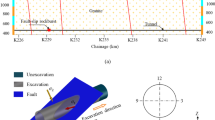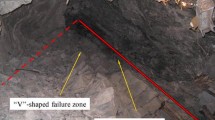Abstract
In this work, an extremely intense fault-slip rockburst case, with a local magnitude of 2.3, observed in a deep tunnel in southwestern China was introduced as a case study. The rockburst caused a large economic loss and delayed the construction schedule for nearly 2 months. In-situ failure analysis, geological surveys, and microseismic (MS) monitoring were carried out to study the development and occurrence mechanisms of fault-slip rockburst. The fault-slip rockburst occurred in the hanging wall of a structure plane with dark green filling material and the rock mass slipped along the structure plane. It shows characteristic of intermittent occurrence, which results in great psychological pressure on workers. The dominant frequency of the rockburst MS event during the fault-slip rockburst is 13 Hz, which shows that the fault slip rockburst can be captured by the MS monitoring system. Extremely intense MS activity was recorded during the rockburst. The development and occurrence processes of the fault-slip rockburst were studied using this MS information. The stress evolution during the rockburst was studied by analyzing the dynamic stress drop. For the evolution mechanism of the fault-slip rockburst, many tensile fracture events occurred during the development stage, and a few shear fractures, corresponding to structure plane dislocation, occurred before the occurrence of the fault-slip rockburst. The presence of a large natural structure plane resulted in a higher stress and crack extension, and reduced the length of the penetration path, resulting in a stronger destructiveness. The results can be used for the further research on fault-slip rockbursts and planning appropriate warning and mitigation measures.
Highlights
-
An extremely intense fault-slip rockburst with local magnitude of 2.3 in a deep tunnel was introduced.
-
Occurrence characteristics of fault-slip rockburst were analyzed.
-
The development and occurrence mechanisms of the fault-slip rockburst including the fracture type and evolution mechanism, were studied.




















Similar content being viewed by others
References
Andrews DJ (1986) Objective determination of source parameters and similarity of earthquakes of different size. Geophys Monogr 37(6):259–267
Brace WF, Byerlee JD (1966) Stick-slip as a mechanism for earthquakes. Science 153(3739):990–992
Cai W, Dou LM, Li ZL, He J, He H, Ding YL (2014) Mechanical initiation and propagation mechanism of a thrust fault: a case study of the Yima Section of the Xiashi-Yima Thrust (North Side of the Eastern Qinling Orogen, China). Rock Mech Rock Eng 48(5):1927–1945. https://doi.org/10.1007/s00603-014-0666-x
Deng SX, Li J, Jiang HM, Wang MY (2018) Experimental and theoretical study of the fault slip events of rock masses around underground tunnels induced by external disturbances. Eng Geol 233:191–199. https://doi.org/10.1016/j.enggeo.2017.12.007
Durrheim RJ, Haile A, Roberts MKC, Schweitzer JK, Spottiswoode SM, Klokow JW (1998) Violent failure of a remnant in a deep South African gold mine. Tectonophysics 289:105–116
Feng XT, Chen BR, Li SJ, Zhang CQ, Xiao YX, Feng GL, Zhou H, Qiu SL, Zhao ZN, Yu Y, Chen DF, Ming HJ (2012) Studies on the evolution process of rockbursts in deep tunnels. J Rock Mech Geotech Eng 4(4):289–295. https://doi.org/10.3724/sp.J.1235.2012.00289
Feng GL, Feng XT, Chen BR, Xiao YX, Yu Y (2015a) A microseismic method for dynamic warning of rockburst development processes in tunnels. Rock Mech Rock Eng 48(5):2061–2076. https://doi.org/10.1007/s00603-014-0689-3
Feng GL, Feng XT, Chen BR, Xiao YX, Jiang Q (2015b) Sectional velocity model for microseismic source location in tunnels. Tunn Undergr Space Technol 45(45):73–83. https://doi.org/10.1016/j.tust.2014.09.007
Feng XT, Xiao YX, Feng GL, Yao ZB, Chen BR, Yang CX, Shao SG (2019) Study on the development process of rockbursts. Chin J Rock Mech Eng 38(4):649–673. https://doi.org/10.13722/j.cnki.jrme.2019.0103
Feng XT, Yang CX, Kong R, Zhao J, Zhou YY, Yao ZB, Hu L (2021) Excavation-induced deep hard rock fracturing: methodology and applications. J Rock Mech Geotech Eng. https://doi.org/10.1016/j.jrmge.2021.12.003
Feng GL, Chen BR, Xiao YX, Jiang Q, Li PX, Zheng H, Zhang W (2022) Microseismic characteristics of rockburst development in deep TBM tunnels with alternating soft–hard strata and application to rockburst warning: a case study of the Neelum-Jhelum hydropower project. Tunn Undergr Space Technol 122:104398. https://doi.org/10.1016/j.tust.2022.104398
Gibowicz SJ (1998) Partial stress drop and frictional overshoot mechanism of seismic events induced by mining. Pure Appl Geophys 153:5–20. https://doi.org/10.1007/s000240050182
Gibowicz SJ, Young RP, Talebi S, Rawlence DJ (1991) Source parameters of seismic events at the underground research laboratory in Manitoba, Canada—scaling relations for events with moment magnitude smaller than − 2. Bull Seismol Soc Am 81(4):1157–1182
Hoek E, Kaiser PK, Bawden WF (1995) Support of underground excavations in hard rock. A. A. Balkenma, Rotterdam
Hu L, Feng XT, Xiao YX, Wang R, Feng GL, Yao ZB, Niu WJ, Zhang W (2020) Effects of structural planes on rockburst position with respect to tunnel cross-sections: a case study involving a railway tunnel in China. Bull Eng Geol Environ 79(2):1061–1081. https://doi.org/10.1007/s10064-019-01593-0
Jiang LS, Kong P, Zhang PP, Shu JM, Wang QB, Chen LJ, Wu QL (2019) Dynamic analysis of the rock burst potential of a longwall panel intersecting with a fault. Rock Mech Rock Eng 53(4):1737–1754. https://doi.org/10.1007/s00603-019-02004-2
Jiang JQ, Su GS, Zhang XH, Feng XT (2020) Effect of initial damage on remotely triggered rockburst in granite: an experimental study. Bull Eng Geol Environ 79(6):3175–3194. https://doi.org/10.1007/s10064-020-01760-8
Kato N, Satoh T, Lei X, Yamamoto K, Hirasawa T (1999) Effect of fault bend on the rupture propagation process of stick-slip. Tectonophysics 310:81–99. https://doi.org/10.1016/S0040-1951(99)00149-3
Leveille P, Sepehri M, Apel DB (2017) Rockbursting potential of kimberlite: a case study of diavik diamond mine. Rock Mech Rock Eng 3:1–9. https://doi.org/10.1007/s00603-017-1294-z
Li TB, Ma CC, Zhu ML, Meng LB, Chen GQ (2017) Geomechanical types and mechanical analyses of rockbursts. Eng Geol 222:72–83. https://doi.org/10.1016/j.enggeo.2017.03.011
Li P, Cai MF, Guo QF, Lu XG, Yan BQ (2018) Research situations and development tendencies of fault slip rockburst in coal mine. J Harbin Inst Technol 50(3):1–17
Lu CP, Liu Y, Zhang N, Zhao TB, Wang HY (2018) In-situ and experimental investigations of rockburst precursor and prevention induced by fault slip. Int J Rock Mech Min Sci 108:86–95. https://doi.org/10.1016/j.ijrmms.2018.06.002
Lu CP, Liu B, Liu B, Liu Y, Wang HY, Zhang H (2019) Anatomy of mining-induced fault slip and a triggered rockburst. Bull Eng Geol Environ 78:5147–5160. https://doi.org/10.1007/s10064-019-01464-8
Manouchehrian A, Cai M (2018) Numerical modeling of rockburst near fault zones in deep tunnels. Tunn Undergr Space Technol 80:164–180. https://doi.org/10.1016/j.tust.2018.06.015
Mori J (2003) Stress drops and radiated energies of aftershocks of the 1994 Northridge, California, earthquake. J Geophys. https://doi.org/10.1029/2001jb000474
Niu WJ, Feng XT, Xiao YX, Feng GL, Yao ZB, Hu L (2020) Identification of potential high-stress hazards in deep-buried hard rock tunnel based on microseismic information: a case study. Bull Eng Geol Environ. https://doi.org/10.1007/s10064-020-01973-x
Qi QX, Liu TQ, Shi YW (1995) Mechanism of friction sliding destability of rock burst. Ground Press Strata Control 3–4:174–177
Ruff LJ (1999) Dynamic stress drop of recent earthquakes: variations within subduction zones. Pure Appl Geophys 154:409–431. https://doi.org/10.1007/s000240050237
Ryder JA (1988) Excess shear stress in the assessment of geologically hazardous situations. J S Afr Inst Min Metall 88(1):27–39
Scholz CH (1998) Earthquakes and friction laws. Nature 391:36–42. https://doi.org/10.1038/34097
Snelling PE, Godin L, McKinnon SD (2013) The role of geologic structure and stress in triggering remote seismicity in Creighton Mine, Sudbury, Canada. Int J Rock Mech Min Sci 58:166–179. https://doi.org/10.1016/j.ijrmms.2012.10.005
Song YM, Peng MS, Yang XB, Jiang YD (2011) Experimental investigation on instability transient process of fault rockburst. Chin J Rock Mech Eng 30(4):812–817. https://doi.org/10.1007/s12583-011-0163-z
Williams TJ, Wideman CJ, Scott DF (1992) Case history of a slip-type rockburst. PAGEOPH 139(3/4):627–637. https://doi.org/10.1007/BF00879955
Xiao YX, Feng XT, Hudson JA, Chen BR, Feng GL, Liu JP (2015) ISRM Suggested method for in situ microseismic monitoring of the fracturing process in rock masses. Rock Mech Rock Eng 49(1):343–369. https://doi.org/10.1007/s00603-015-0859-y
Xiao YX, Feng XT, Feng GL, Liu HJ, Jiang Q, Qiu SL (2016a) Mechanism of evolution of stress–structure controlled collapse of surrounding rock in caverns: a case study from the Baihetan hydropower station in China. Tunn Undergr Space Technol 51:56–67. https://doi.org/10.1016/j.tust.2015.10.020
Xiao YX, Feng XT, Li SJ, Feng GL, Yu Y (2016b) Rock mass failure mechanisms during the evolution process of rockbursts in tunnels. Int J Rock Mech Min Sci 83:174–181. https://doi.org/10.1016/j.ijrmms.2016.01.008
Younga RP, Collinsb DS (2001) Seismic studies of rock fracture at the Underground Research Laboratory, Canada. Int J Rock Mech Min Sci 38:787–799. https://doi.org/10.1016/S1365-1609(01)00043-0
Zhang CQ, Feng XT, Zhou H, Qiu SL, Wu WP (2012) Case histories of four extremely intense rockbursts in deep tunnels. Rock Mech Rock Eng 45(3):275–288. https://doi.org/10.1007/s00603-011-0218-6
Zhang W, Feng XT, Xiao YX, Feng GL, Yao ZB, Hu L, Niu WJ (2020) A rockburst intensity criterion based on the geological strength index, experiences learned from a deep tunnel. Bull Eng Geol Environ 79(7):3585–3603. https://doi.org/10.1007/s10064-020-01774-2
Zhang W, Feng X, Bi X, Yao Z, Xiao Y, Hu L, Niu W, Feng G (2021) An arrival time picker for microseismic rock fracturing waveforms and its quality control for automatic localization in tunnels. Comput Geotech 135:104175. https://doi.org/10.1016/j.compgeo.2021.104175
Zhao ZN, Feng XT, Chen BR et al (2013) Study of relativity between rockburst and MS activity zone in deep tunnel. Rock Soil Mech 34(2):491–497 ((in Chinese))
Zhao TB, Guo WY, Tan YL, Yin YC, Cai LS, Pan JF (2018) Case studies of rock bursts under complicated geological conditions during multi-seam mining at a depth of 800 m. Rock Mech Rock Eng 51(5):1–26. https://doi.org/10.1007/s00603-018-1411-7
Zhao YF, Jing G, Fan Y, Pan YS (2020) Experimental study on the microseism and charge signal time-frequency characteristics in the process of fault stick-slip instability. Chin J Rock Mech Eng. https://doi.org/10.13722/j.cnki.jrme.2019.1025
Acknowledgements
The authors gratefully acknowledge financial support from the National Natural Science Foundation of China under Grant no. 51839003, the 111 Project under Grant no. B17009 and the Liao Ning Revitalization Talents Program under Grant no. XLYCYSZX1902.
Author information
Authors and Affiliations
Corresponding author
Additional information
Publisher's Note
Springer Nature remains neutral with regard to jurisdictional claims in published maps and institutional affiliations.
Rights and permissions
About this article
Cite this article
Zhang, W., Feng, XT., Yao, ZB. et al. Development and Occurrence Mechanisms of Fault-Slip Rockburst in a Deep Tunnel Excavated by Drilling and Blasting: A Case Study. Rock Mech Rock Eng 55, 5599–5618 (2022). https://doi.org/10.1007/s00603-022-02927-3
Received:
Accepted:
Published:
Issue Date:
DOI: https://doi.org/10.1007/s00603-022-02927-3




